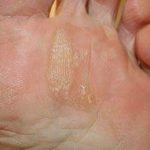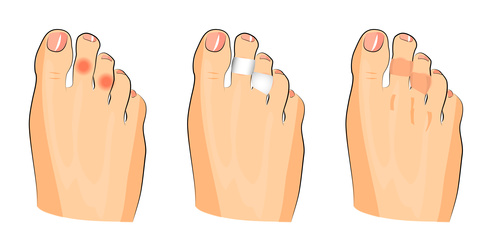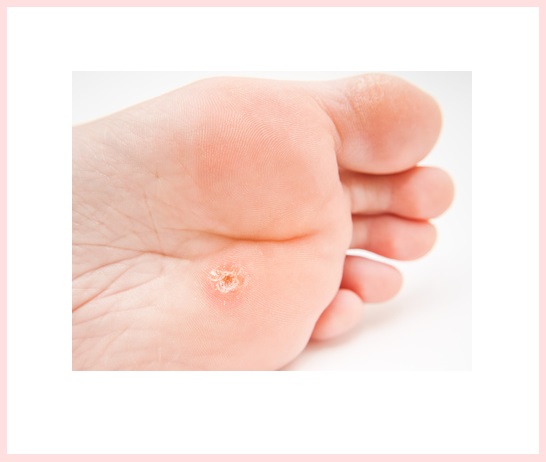Causes of Corns and Callus
Corns and Callus appear on your feet as yellowish lumps made up of dead dry skin. If you have been active the skin surrounding the lumps may be very red or bright pink. The associated pain can range from nothing to excruciating.
How does skin normally work?
Human skin is made up of many layers. The outer layer is constantly peeling off, refreshing your skin over and over again. This peeling off is happening at a cellular level, so usually you don’t even notice it happening. Normally the outer layers of skin peel away when you wash and dry your feet or just with everyday rubbing against your socks. If you spend a lot of time with feet bare, the skin will be rubbing off against your floors, carpets,whatever you are walking or standing on. All of this is normal. New skin develops, old skin disappears..all in balance.
How do corn or callus form?

However, sometimes the balance of new and old skin gets disturbed. All of a sudden there is too much extra skin and the body, instead of peeling it away, accumulates it. The balance once disturbed becomes the new normal. Too much skin forming ugly, painful lumps and bumps of dead skin. The accumulated dead skin is called either a corn (heloma) or a callus (hyperkeratosis).
Both corns and calluses are caused by friction and pressure when the bony parts of your feet rub against your shoes, or other bones. A callus forms when the friction and pressure occur over a larger area. A corn forms when the friction and pressure occur over a much more specific area.
Other non-callus lumps
There are lumps that can form on the feet that are not corn or callous. It can be helpful to have a professional have a look at your feet to ensure that you don’t have something other than corns or callus.
Treatments for Corns and Callus
Corns and calluses will go away or improve if the friction and pressure reduces. Discovering the cause can be a surprising process. Sometimes you need to use more than one strategy.
- Improve the skin flexibility, resilience and tone. For this you will need to use a quality skin moisturizer. There are so many to choose from, but start with a non-perfumed hand moisturizer.
- Improve the shoes that you wear that you wear most of the time.Are your shoes rubbing across the top, rubbing on your toes? Do you toes feel squeezed into the front? Do you feel like you are walking on rocks? Not enough cushioning? Maybe these shoes should NOT be your everyday shoes.Are your everyday shoes the correct length and width?Do you slop around in your shoes? Are they too big?
Best tips for corns on toes are:
- Wear shoes with no seams across the toes.
- Check that your shoes have enough room for your toes. Depth as well as width.
- Buy toe protectors from the Pharmacist or supermarket (not suitable for people with diabetes or poor circulation).
Great tips for callus and corns on the bottom of your feet:
- Slip a gel insole in the bottom of your shoes.
- Apply moisturizing cream daily. Often a cream that contains UREA to the area of the corn/callus may be more effective
- Use a file once or twice a week to gently file away the patches of hard skin.
Tips for corns between the toes (Soft corns):
- Corns between the toes are caused when the small bones in the toes rub against the skin.
- The best way to slow these corns coming back is by putting something between the toes to stop them rubbing
- Gel , foam, silicone …lots of products are available
Can I use Over the Counter Corn treatments?:
Over-the-counter treatments (“corn cures”) contain acids destroy any skin they come in contact with but do not treat the cause., In the short term they may help but long term they are of little use. Unless the real problem is found – the corn will just keep coming back. If you are unsure if you can use them – check with your Podiatrist, Pharmacist or Doctor first. If you have diabetes or poor circulation or have healing problems you should NEVER use them.
Can I use corn planes / blades?:
If you have diabetes, poor circulation or have a weakened immune system using a corn plane or a blade can be very dangerous. Podiatrists advise NOT to use these. Using a corn plane you run the risk of badly cutting your foot. Sharing a blade with someone else can also be very risky. You need to decide what risks you will take with your skin.

It doesn’t need to be a competition between your favorite shoe and how much pain you can tolerate. Just a few simple steps may keep you looking glamorous and smiling. Moisturize, protect choose wisely and step out with confidence.





